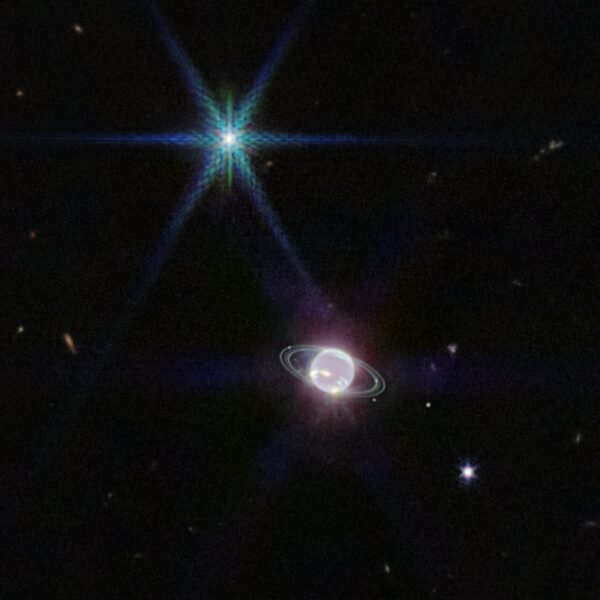Three solar system emissaries have returned beautiful and even interactive vistas of Neptune, Jupiter, and Mars.
A New View of Neptune's Rings

NASA / ESA / CSA / STScI
The James Webb Space Telescope has provided us with another breathtaking image, this time of Neptune and its gossamer rings. We haven't detected some of these rings since Voyager 2's flyby of the planet in 1989.
Neptune itself appears dark in the image because trace amounts of methane in its atmosphere absorb the near-infrared wavelengths Webb was observing. However, high-altitude clouds appear bright because their methane ice crystals reflect sunlight before they can absorb it. A thin line at the equator also appears bright, because this is where the atmosphere warms and sinks.
The image also shows seven of Neptune's 14 known moons, including the brilliant Triton, surfaced in highly reflective frozen nitrogen, at upper left. Because Triton is much brighter than Neptune, it carries Webb's characteristic diffraction spikes.
"Frosted Cupcake" Clouds on Jupiter
Reporting at the 2022 Europlanet Science Congress, citizen scientist, mathematician, and software developer Gerald Eichstädt presented a new view of data from NASA's Juno spacecraft, which is still whizzing around our system's largest planet every 43 days.
Flying 13,500 km above Jupiter's cloudtops, Juno recorded the intensity of visible light. Since brighter clouds typically correspond to higher-elevation clouds, Eichstädt was able to plot the visible light intensity in 3D to portray the clouds' appearance:
The data came from JunoCam, a camera placed on the spacecraft primarily for public engagement. Citizen scientists such as Eichstädt have transformed this camera's visible-light images into beautiful Jovian panoramas.
Now, Eichstädt's new look at some of that data reveals more about the workings within the swirling clouds, showing how some rise to much higher elevations than others. There's more work to be done to sort out how the clouds' chemical compositions (which can also be deduced from Juno data) affect their height.
Roll with Perseverance in Jezero Crater
Experience Jezero Crater in 3D with a new visualization presented by Sebastian Walter (Free University of Berlin) at the 2022 Europlanet Science Congress. The interactive map shows Perseverance's drive thus far, including waypoints to which you can drop down and step into the scene.
If you have a virtual reality setup, you can really get into the immersive experience, but even accessing the panoramas with a smartphone will provide 3D views of the landing site, the crater center, and the delta left behind by the river that once flowed into Jezero.
The base layer map comes from instruments on the European Space Agency's Mars Express and NASA's Mars Reconnaissance Orbiter, both of which provide sharp images of the terrain around Perseverance. Some of the panoramas are digitally rendered from the orbital data; other panoramas come from the rover's own cameras.
“Initially we created the Jezero map as an outreach application,” Walter says. “But as the rover returns more and more high-resolution image data and even audio recordings, it turns out to be the perfect tool for immersive visualisation of that data in a scientific context by itself.”
There's at least one Easter egg to be found in the map — go to the Panoramic Views on the lefthand navigation and click on Hogwallow Flats to “roll” with Perseverance. Just make sure you have your volume on!
 1
1









Comments
Anthony-Mallama
September 23, 2022 at 11:12 am
The Jezero crater VR panoramas are amazing. 'Paleo lake view' with the water level filled in is especially intriguing. A wonderful article with the Neptune and Jupiter news, too.
You must be logged in to post a comment.
You must be logged in to post a comment.